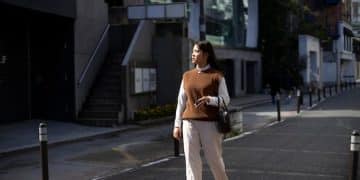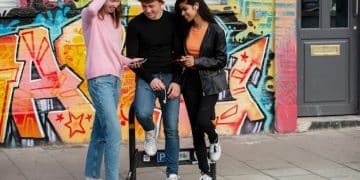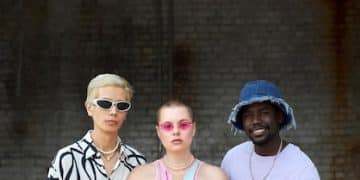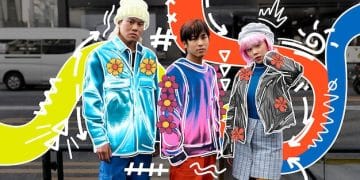Streetwear Silhouettes: Mastering Proportions for 2025 Impact

Mastering proportions is fundamental to excelling in streetwear fashion, as it allows for the creation of balanced and impactful outfits that transcend simple clothing choices, defining personal style and influencing trends for 2025.
In the dynamic world of urban fashion, mastering the art of balancing elements is key. This detailed guide, The Ultimate Guide to Streetwear Silhouettes: Mastering Proportions for Maximum Impact in 2025, aims to demystify how silhouette and proportion shape a truly impactful streetwear aesthetic. We will explore how these foundational principles can elevate your style beyond fleeting trends, ensuring your wardrobe remains relevant and striking as we head towards 2025.
Understanding the Basics: Silhouette and Proportion in Streetwear
Before diving deep into specific styles, it’s crucial to grasp the fundamental concepts of silhouette and proportion within the streetwear context. These aren’t just academic terms; they are the bedrock upon which all compelling outfits are built, dictating how garments interact with the body and with each other.
Silhouette refers to the overall outline or shape a garment, or an entire outfit, creates against the body. Think of it as the outer edge or form when viewed from a distance. In streetwear, silhouettes often range from extremely oversized and relaxed to more structured and fitted, each conveying a distinct message and attitude.
Proportion, on the other hand, deals with the relationship of sizes and shapes within an outfit. It’s about how the different pieces—tops, bottoms, outerwear, and even accessories—balance each other out. Effective proportion ensures that no single element overwhelms another, creating visual harmony and enhancing the wearer’s natural form rather than detracting from it. Mastering this allows for endless creativity in mixing and matching.
The interplay of fit and form
The fit of a garment directly influences its silhouette. A baggy t-shirt naturally creates a different silhouette than a slim-fit tee. Understanding how various fits contribute to the overall shape is essential for manipulating proportions effectively. This foundation is critical for any fashion enthusiast looking to make a statement.
- Oversized: Garments designed to be intentionally larger than the wearer’s typical size, creating a relaxed, often voluminous silhouette.
- Relaxed Fit: Offers more room than a regular fit but isn’t as voluminous as oversized, providing comfort without excessive bagginess.
- Slim Fit: Follows the body’s contours closely without being skin-tight, offering a streamlined and modern look.
- Tailored Fit: Modified to precisely fit the wearer’s body, often with structured elements that define a sharper silhouette.
Ultimately, silhouette and proportion aren’t just about what looks good; they are about personal expression. By understanding these basics, you gain the vocabulary to articulate your style, experiment with confidence, and build outfits that resonate with your unique aesthetic. This knowledge empowers you to move beyond simply following trends to creating them.
The Evolving Landscape of Streetwear Silhouettes in 2025
As we approach 2025, the streetwear landscape continues its dynamic evolution, influenced by global trends, technological advancements, and a growing emphasis on sustainability. The silhouettes observed today are a fascinating blend of revisited classics and innovative new forms, pushing the boundaries of traditional garment construction.
One significant direction is the continued embrace of exaggerated proportions. While oversized fits have been a staple for years, 2025 sees an even greater emphasis on volume, especially in outerwear and trousers. Think voluminous puffer jackets, wide-leg utility pants, and incredibly baggy denim. This push for extra space creates a fluid, often dramatic silhouette that allows for layering and movement.
Blurring lines and functional aesthetics
Another emerging trend is the blurring of lines between formal and casual wear, leading to hybrid silhouettes. Tailored pieces are being deconstructed and reintegrated into streetwear outfits, such as oversized blazers paired with track pants, or structured shirts worn untucked over graphic tees. This reflects a desire for versatility and a rejection of rigid dress codes, emphasizing comfort without sacrificing sophistication.
- Modular Design: Garments with detachable elements, allowing wearers to alter their silhouette and function on the fly.
- Gender-Neutral Forms: A rise in garments designed without specific gendered silhouettes, favoring universal appeal and adaptable fits.
- Sustainable Fabrics: The integration of recycled, upcycled, and innovative eco-friendly materials influencing drape and structure.
Furthermore, technology plays an increasingly vital role. Smart textiles and innovative fabrication techniques are enabling new interpretations of traditional silhouettes, allowing for enhanced breathability, weather resistance, and unique textural expressions. These technological advancements are not just about function; they actively shape the visual and tactile qualities of silhouettes.
The foresight for 2025 also includes a strong undercurrent of nostalgia, with certain iconic silhouettes from the late 90s and early 2000s making significant comebacks, albeit reinterpreted with modern sensibilities. This blend of retrospective influence and forward-thinking design ensures that streetwear remains fresh, exciting, and perpetually relevant.
Mastering the Oversized Fit: Balance and Intentionality
The oversized fit is arguably one of the most defining characteristics of contemporary streetwear, offering comfort, a distinct aesthetic, and a canvas for bold expression. However, truly mastering it goes beyond simply wearing clothes that are too big. It requires an understanding of balance, intentionality, and how to manipulate proportions to achieve a cohesive and impactful look.
The key to success with oversized pieces lies in contrast. When opting for an oversized top, consider pairing it with a more streamlined bottom, or vice versa. This creates visual interest and prevents the outfit from looking shapeless or overwhelming. For instance, a very wide and long t-shirt can be balanced with straight-leg or slightly tapered pants.
Strategic layering and fabric choice
Layering is another powerful tool when working with oversized silhouettes. An oversized hoodie worn under an even more voluminous trench coat creates depth and texture, allowing the different layers to interact and form a complex, yet harmonious, outline. The interplay of various lengths and fits within these layers is crucial for a dynamic appearance.
- Cropping: Experiment with cropped oversized tops or jackets to reveal a slice of a more fitted inner layer, adding dimension.
- Fabric Draping: Choose fabrics that drape well, likejersey or soft fleece, as they allow oversized garments to fall gracefully rather than appearing stiff or bulky.
- Accessories: Use accessories like belts, fanny packs, or chest rigs to cinch in or define the waist, adding structure to an otherwise loose silhouette.

Furthermore, the choice of footwear plays a significant role in anchoring an oversized outfit. Chunky sneakers or boots often complement the voluminous nature of oversized clothing, contributing to the overall balanced proportion from head to toe. Conversely, overly sleek or small shoes can make an oversized outfit look top-heavy.
Remember, the goal isn’t to disappear within your clothes, but to make a deliberate statement. An artfully executed oversized fit speaks volumes about confidence and an understanding of contemporary aesthetics, elevating casual wear to an art form. It’s about owning the space your clothing occupies.
The Allure of Structured and Tailored Streetwear
While oversized and relaxed fits dominate much of the streetwear narrative, a growing appreciation for structured and tailored silhouettes is gaining significant traction. This approach offers a refined contrast, injecting an element of sophistication and precision into the often-casual streetwear ethos. It’s about introducing sharper lines and more deliberate forms without sacrificing the inherent attitude of urban style.
Structured streetwear often involves pieces that maintain a specific shape, such as bomber jackets with stiff collars, wide-leg trousers with crisp pleats, or oversized blazers with defined shoulders. These items, when integrated thoughtfully, can elevate an entire outfit, making it more polished and intentional. The key is in the juxtaposition – pairing structured elements with softer, more relaxed pieces to create a dynamic equilibrium.
The modern utility and workwear influence
The influence of utility and workwear continues to be a cornerstone of structured streetwear. Items like multi-pocket cargo pants, durable canvas jackets, and robust chore coats bring an inherently functional and tailored aesthetic. These pieces often feature reinforced seams and defined cuts, contributing to a silhouette that is both practical and stylish.
- Sharp Outerwear: Invest in bomber jackets, trench coats, or blazers with defined silhouettes that hold their shape.
- Trousers with Intent: Opt for wide-leg pants with pleats or straight-leg trousers that maintain a clean line, avoiding excessive bagginess.
- Layered Precision: Use fitted base layers under structured outerwear to enhance the overall clean lines and avoid bulk.
Moreover, the concept of “power dressing” has subtly found its way into streetwear through structured elements. A well-fitted, yet modernly cut, suit pant paired with a graphic tee and high-end sneakers exemplifies this fusion. It suggests a confidence and a rejection of traditional formality, creating a new idiom for self-expression through clothing.
The beauty of structured streetwear lies in its versatility. It can be dressed down for a casual outing or elevated for a more formal event, simply by adjusting complementary pieces. This adaptability ensures that investing in tailored streetwear pieces offers enduring value, making them timeless additions to any modern wardrobe.
The Cropped Trend: How to Master Proportions with Shorter Lengths
The cropped trend has cemented its place in contemporary streetwear, offering a fresh way to manipulate proportions and add dynamic visual interest to an outfit. From cropped jackets and hoodies to shorter tops and even truncated trousers, incorporating shorter lengths requires a thoughtful approach to ensure balance and aesthetic impact. It’s about revealing just enough to create intrigue and define the waistline, rather than merely showing skin.
When working with cropped tops or outerwear, the key is often to balance the exposed midriff or higher waistline with fuller or longer bottoms. High-waisted baggy jeans, wide-leg cargo pants, or even pleated trousers create a compelling interplay between the shortened top and the voluminous lower half. This contrast elongates the legs and accentuates the torso, crafting a visually appealing silhouette.
Strategic layering and diverse textures
Layering is particularly effective with cropped pieces. A cropped jacket thrown over a standard-length t-shirt or hoodie creates a layered effect that highlights the different hemlines, adding depth. This also allows for experimentation with textures and colors, where a soft cotton tee can peek out from under a structured denim or leather crop jacket.
- High-waisted bottoms: Essential for balancing cropped tops, they help define the waist and maintain a flattering proportion.
- Defined waistline: Cropped items naturally draw attention to the waist, making it an opportune moment to consider belts or other waist-defining accessories.
- Footwear harmony: Chunkier shoes or sneakers can ground the bottom half of an outfit when paired with cropped elements, providing a solid foundation to the higher waistline.
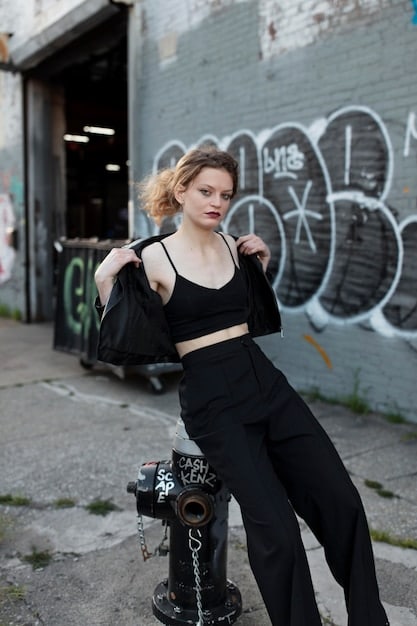
For cropped trousers, the principle remains similar: consider the overall length and how it interacts with footwear. A slightly cropped pant can elegantly highlight a statement sock or a particularly intricate sneaker design. The break in the pant leg, even subtle, can entirely alter the perceived length of the leg and the fluidity of your stride.
Ultimately, embracing the cropped trend is about playing with new vertical proportions. It’s about creating a modern, often edgy look that feels intentional and well-considered. By strategically balancing shorter lengths with appropriate counterparts, you can achieve a sophisticated and fashion-forward streetwear aesthetic that stands out in 2025.
Accessorizing for Silhouette Enhancement: Beyond the Basics
Accessories, often seen as mere afterthoughts, are in fact potent tools for enhancing and manipulating the overall silhouette of a streetwear outfit. They possess the power to define, soften, emphasize, or even completely alter the perceived shape of your clothing, transforming a simple ensemble into a deliberate and impactful statement. Beyond the obvious aesthetic appeal, it’s their proportional contribution that unlocks true styling mastery.
Consider the role of a belt. More than just holding up pants, a wide, cinchable belt can drastically change the silhouette of an oversized shirt or jacket. By pulling in fabric at the waist, it introduces an hourglass or, more commonly in streetwear, a defined midsection, contrasting with the garment’s natural drape. This creates intentional breaks in the flow of fabric, adding structure to a fluid shape.
Headwear, footwear, and their visual weight
Headwear and footwear are particularly influential. A chunky beanie can add height and volume to the upper silhouette, while an oversized, structured cap can broaden the perceived width of the head and shoulders. Conversely, the right pair of shoes can ground an entire outfit. Chunky sneakers, for instance, add visual weight to the lower half, balancing out voluminous tops or accentuating the taper of slim-fit pants.
- Crossbody bags and chest rigs: These items often cut across the torso, breaking up solid blocks of color and adding horizontal or diagonal lines that contribute to the overall silhouette.
- Statement jewelry: While often small, bold chains or rings can draw attention to specific areas, indirectly influencing how the eye perceives the proportions of nearby garments.
- Socks: Often overlooked, high-quality, patterned, or textured socks can bridge the gap between trousers and footwear, adding a crucial transitional element that impacts leg line.
Layering smaller accessories, such as multiple necklaces or stacked bracelets, can also create a clustered visual interest that contributes subtly to the overall texture and depth of a silhouette. It’s about building layers, not just of clothing, but of visual information that contributes to the final form.
Ultimately, thoughtful accessorizing is about understanding how each piece contributes to the grand compositional scheme. By viewing accessories not just as embellishments but as sculptural elements, you unlock new dimensions in silhouette creation, allowing for nuanced and compelling personal expression within the streetwear realm for 2025.
Styling Challenges and Solutions: Common Pitfalls in Proportions
Navigating the nuances of streetwear silhouettes and proportions can present certain challenges. While experimentation is encouraged, some common pitfalls can detract from an otherwise well-intentioned outfit. Recognizing these issues and having practical solutions is crucial for consistently impactful styling as we move into 2025.
One frequent challenge is the “swallowed” look when wearing excessive oversized garments without proper balance. This occurs when both top and bottom pieces are overly voluminous without any definition or contrast, making the wearer appear shapeless. The solution lies in strategic tapering or cropping. Pairing an oversized hoodie with slightly tapered pants or even rolling up sleeves can introduce shape.
Avoiding the “unproportioned” trap
Another pitfall is the misalignment of hemlines, particularly with trousers and outerwear. Pants that are too long can bunch awkwardly, while jackets that are too short for the overall frame can disrupt the visual flow. Pay attention to the “break” of your trousers – where they meet your shoes – and ensure outerwear hits at a flattering point, complementing the rest of the outfit’s length. This often means experimenting with various cuts until you find your ideal.
- Excessive bagginess: Combat this by introducing one more fitted element, such as a snug base layer under an oversized jacket, or a belt to cinch a wide-cut top.
- Top-heavy appearance: If your upper body feels too voluminous, opt for chunkier footwear or bottoms with a wider leg to provide a balanced foundation.
- Lack of definition: Incorporate accessories like vests, fanny packs worn crossbody, or even layered shirts of varying lengths to create visual breaks and accentuate natural lines.
Fabric choice also plays a subtle yet significant role. Stiff, unyielding fabrics in oversized pieces can make an outfit look boxy and unflattering, whereas fabrics with good drape allow for natural movement and flow. Understanding how different materials lie and fall on the body is essential for avoiding rigidity and maintaining a fluid aesthetic.
Ultimately, becoming adept at mastering proportions is an ongoing learning process. It requires a keen eye, a willingness to experiment, and a critical self-assessment. By addressing these common styling challenges with thoughtful solutions, you can elevate your streetwear game, ensuring every outfit is not just worn, but truly owned, for maximum impact.
| Key Point | Brief Description |
|---|---|
| 📏 Silhouette & Proportion | The foundation for impactful streetwear; silhouette is outline, proportion is balance within an outfit. |
| ⬆️ Oversized Mastery | Balance voluminous tops with streamlined bottoms, and vice versa. Layering adds depth. |
| ✂️ Cropped Trend | Pair shorter lengths with high-waisted or fuller bottoms to define the waist and elongate legs. |
| 🔗 Accessories As Tools | Belts, bags, and footwear significantly alter form, add structure, and influence visual balance. |
Frequently Asked Questions About Streetwear Silhouettes
▼
The most crucial aspect is understanding proportion. It’s about how different pieces of clothing relate to each other in terms of size and shape. Achieving balance between elements, whether contrasting oversized with fitted, or mixing lengths, ensures a cohesive and visually appealing outfit, making a strong impact.
▼
To make oversized looks intentional, focus on contrast and subtle definition. Pair a loose top with more tapered bottoms, or vice versa. Consider tucking a portion of the top, rolling up sleeves, or using a belt to create a waistline. Fabric choice also matters; opt for materials that drape well.
▼
Yes, tailored pieces are increasingly part of streetwear. They introduce a refined, structured silhouette. They are incorporated by pairing them with casual elements, like an oversized blazer with joggers, or pleat-front trousers with sneakers. This fusion creates a sophisticated yet relaxed aesthetic, blending formal lines with urban edge.
▼
Accessories play a significant role. Belts can cinch oversized garments, altering their shape. Crossbody bags create diagonal lines, breaking up large blocks of fabric. Footwear, especially chunky sneakers, adds visual weight to the lower body, balancing top-heavy outfits. They are crucial for adding definition and structure to an overall look.
▼
A common pitfall is creating outfits where all elements are overly voluminous, leading to a “swallowed” or shapeless appearance. Avoid this by ensuring at least one element provides some contrast or definition, whether it’s a more fitted piece, a strategic tuck, or the use of accessories to add structure and break up proportions effectively.
Conclusion
As we’ve explored throughout this guide, mastering streetwear silhouettes and proportions is far more than simply following fleeting trends; it’s about understanding the core principles that elevate personal style. By embracing the interplay of outline and internal balance, you gain the power to craft outfits that are not only aesthetically pleasing but also reflective of individual expression. The evolving landscape of streetwear in 2025 calls for intentionality, a keen eye for detail, and a willingness to transcend conventional styling rules. By applying these insights, from expertly managing oversized fits to strategically deploying accessories, you will undoubtedly maximize your impact, ensuring your presence in the urban fashion scene is both confident and undeniably stylish.
